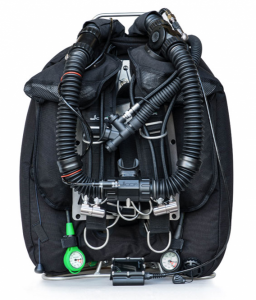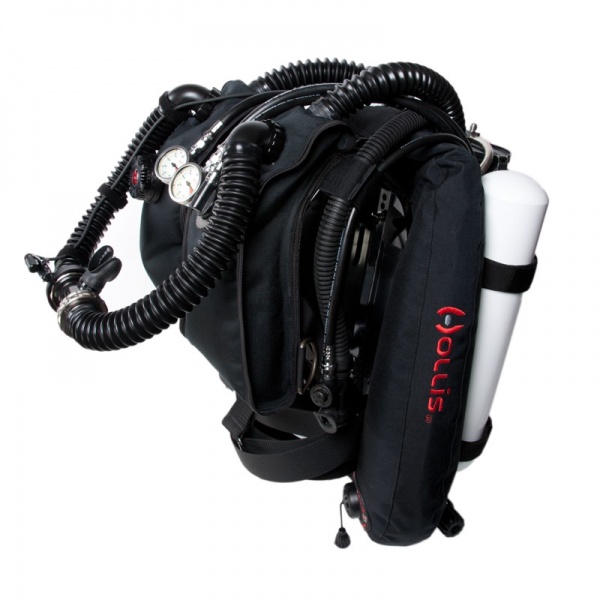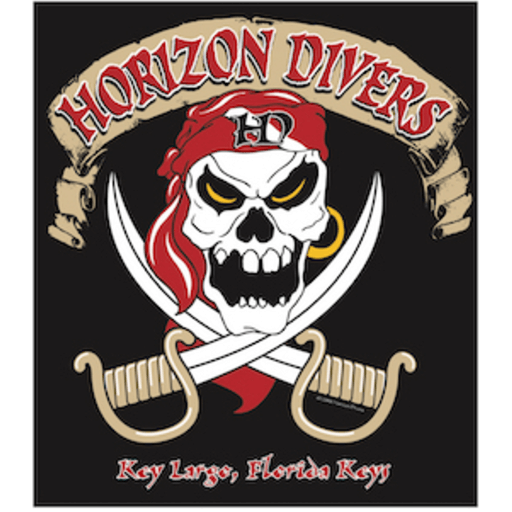Rebreathers
Horizon Divers – Dive Courses
JJ CCR
This is the new JJ-CCR CE-Edition, launched in August 2014. Equipped with a Petrel computer, a digital HUD, manual supplemental O2 and diluent valves with the option of feeding in external gases. The rebreather comes ready to fly right out of the box. Fill it with gas and sofnolime and serious adventures is just about to begin.
The philosophy behind the JJ-CCR is to keep it simple; K.I.S.S. simple… The JJ-CCR has a robust construction with minimalistic detail work. It gives the diver a versatile rebreather, still very easy to handle as well as to deal with before and after operations. It is a rebreather built by divers and diving engineers.

All components has a purpose and every detail can be justified in order to perform as a system helping the diver to reach his goals. The JJ-CCR is equipped with state of the art electronics and computing but it will still demand a skilled diver fully aware of the Pro’s and Con’s of technical rebreathers.
The JJ-CCR is an extremely versatile rebreather which is helping JJ-CCR divers to reach fantastic places. Click here to contact us with any other questions you have.
Essential features of the JJ-CCR Rebreather
- Highly robust aluminium housing to which it is possible to secure up to 4
diving tanks (2 – 12 litre) using conventional tank belts. - Self-filling soda lime canister (axial or optionally additionally radial)
- Heavy duty stand
- Integrated handle
- Back-mounted counter lungs
- Redundant power supply: One battery for the controller,
one battery for the HUD and two parallel batteries for the
solenoid. None of the batteries are integrated into the loop. - Integrated ADV (Automatic Diluent Valve)
- DSV (Dive Surface Valve)
- Valve for manual oxygen feeding with the option of feeding in external
gases – also optional for the diluent - Independent Digital HUD (Head Up Display) with real-time display of PPO2
for all three oxygen sensors - Reliable controller with an integrated multi-gas decompression
computer (based on the Shearwater Petrel) - Supplemental manual diluent inflation (JJ-CCR Rebreather DiveCAN – CE Edition)
- Diiuent inline shut-off valve (JJ-CCR Rebreather DiveCAN – CE Edition)
Hollis PRISM2 Rebreather
The Prism2 is a fully closed circuit Rebreather, ideal for exploring open ocean, cave, or wrecks. This unit can be electronically or manually controlled which means you choose how you want the loop PPo2 maintained. Includes shoulder mounted counter lungs and rear mounted radial scrubber which provide easy breathing with low resistive effort and low hydrostatic loading. The standard kit includes an electronic secondary control and primary LED displays with a backplate/wing assembly that provides a complete kit ready to dive out of the box. Unit can also be purchased with or without tanks/valves

Learn More About Classes, Click Below
Horizon Divers – Dive Courses
Want to try cutting-edge dive equipment and learn about rebreather technology? The Discover Rebreather program is your opportunity to try a recreational rebreather or a technical Closed Circuit Rebreather (CCR) in controlled conditions. The program is open to certified divers at least 18 years of age who have logged at least 15 dives.
During the program, you’ll learn:
1. the differences between rebreathers and open circuit scuba
2. about the two basic rebreather types
3. how rebreathers function
You’ll also get in the water for a rebreather dive. Your PADI Rebreather Instructor or Tec CCR Instructor will show you new hand signals specific to rebreather diving and you’ll learn what the rebreather is telling you through the handset, heads up display (HUD) and audible alarms. You’ll also discover the differences in buoyancy control while descending, ascending and hovering in a rebreather, adjust the mouthpiece and bail out to open circuit. You’ll do all of this in the clear, calm waters of a pool or confined water so you can discover the new challenges and benefits of rebreather diving.
The Discover Rebreather program is an ideal opportunity to learn about this emerging technology.
Think rebreathers are just for technical diving? Think again because the latest rebreathers are lightweight, easy-transportable units that use sophisticated electronics to simplify their use. Rebreathers allow longer no decompression limits, reduced gas consumption and unmatched wildlife encounters.
What is a rebreather?
The primary difference between rebreathers and open-circuit units is that rebreathers reuse some or all of the gas you exhale. There are two basic types of rebreathers: closed-circuit rebreathers (CCRs) and semi-closed rebreathers (SCRs).
The PADI Rebreather and Advanced Rebreather Diver courses use Type R units to introduce divers to rebreather diving within recreational dive limits. Type R rebreathers are electronically controlled and provide a back up for all the major systems and simplify training and use.
All rebreathers used during PADI courses must be third-party tested and manufacturers must ensure they meet a comprehensive list of requirements.
Because each rebreather model is different, you will need to qualify on each rebreather model. However, once you are qualified you will not need to repeat the entire course to earn your certification with a different Type R rebreather model. The PADI Rebreather Qualifier focuses on the knowledge and skills needed to use a different Type R rebreather model.
PADI Rebreather Diver
In this entry-level rebreather program you will learn to use Type R rebreathers to a maximum of 18 metres/60 feet within no decompression limits.
Prerequisites:
• PADI Open Water Diver and PADI Enriched Air Diver certifications (or qualifying certifications from a recognized organization).
• 25 logged dives
• 18 years old
This course expands on the basic knowledge you have already acquired and provides training to a maximum of 30 metres/98 feet (40 metres/130 feet if you have a PADI Deep Diver certification), including carrying a bailout cylinder.
Prerequisites:
• PADI Open Water Diver and PADI Rebreather Diver certifications (or qualifying certification from a recognized organization) on the Type R rebreather used in the course
• 30 logged dives
• 18 years old
• PADI Advanced Open Water Diver certification (prior to PADI Advanced Rebreather Diver certification)
Tec 40 CCR Diver Course
Learn to plan and make dives using air diluent and air or enriched air (EANx) bailout gas on Type T (technical) closed-circuit rebreathers (CCR) to a maximum of 40 metres/130 feet with a single decompression stop of no more than 10 minutes.
Tec 40 CCR Diver is the first level of training that addresses technical diving with Type T CCRs, which include a range of electronic CCRs (eCCRs) and manual CCRS (mCCRs). Tec 40 CCR Diver introduces student divers to diagnosing life-support problems and, when possible, returning to the loop to complete the dive with limited decompression obligations.
This training is significantly more challenging than recreational rebreather diving because divers learn to be both a tec diver as well as learning to tec dive with a CCR.
Prerequisites:
• PADI Advanced Open Water Diver, PADI Enriched Air Diver, PADI Deep Diver (or have experience of more than 10 dives to 30 metres/100 feet) certification and at least 30 dives logged with specific experience requirements.
• Prior to Training Dive Five, student divers must be certified as PADI Rescue Divers
• Prior to certification, student divers must have 50 dives logged.
• There are provisions for other qualifying certifications.
• 18 years old
What is a closed-circuit rebreather?
Closed-circuit rebreathers are a type of scuba that reuses the gas you exhale. This is the primary difference between CCR and open-circuit scuba.
All CCRs used on PADI TecRec CCR courses must be third party tested and manufacturers must ensure they meet a comprehensive list of requirements and register them with PADI.
Tec 40 CCR Qualifier program
Due to differences between CCRs, divers qualify on each CCRs, however, once qualified you will not need to repeat the entire course if you want to learn to dive a different Type T CCR. The Tec 40 CCR Qualifier focuses on the knowledge and skills divers need to cross over from one Type T CCR to another.
Background on Closed Circuit Rebreathers
Technical diving has been revolutionized by the development, availability and reliability of Closed Circuit Rebreathers. CCRs provide numerous benefits to the technical diver, including: reduced gas consumption, optimum EANx blends for decompression and a wider range of solutions to equipment problems. Consequently CCRs potentially allow the technical diver a greater access to time underwater – greater time based on gas logistics when compared with an open circuit technical diver and more time available to find solutions to gas management problems. As time is a critical and a finite resource divers wanting to dive at and beyond the recreational envelope can now choose PADI Technical CCR training to achieve their goals.
Tec 60 CCR Diver is an intermediate technical Closed Circuit Rebreather (CCR) diver program where you’ll learn to use life support equipment in completing dives outside the recreational and air diluent envelope.
You will learn to plan and make dives using trimix/heliox (minimum 16% oxygen) as a diluent using a Type T CCR to a maximum depth of 60 metres/200 feet and complete multiple decompression stops while carrying adequate bail out gas for the dive.
Tec 60 CCR Diver is the second level of training that addresses technical diving with Type T CCRs, which include a range of electronic CCRs (eCCRs) and manual CCRs (mCCRs). Tec 60 CCR develops the understanding and skills for diagnosing life-support problems while using trimix/heliox to complete a technical dive with its necessary decompression obligations.
Prerequisites:
• Tec 40 CCR Diver or other qualifying certification
• Proof of 150 logged dives, with at least 25 dives and 50 hours experience with the Type T CCR used in the course with an offboard bailout system following Tec 40 CCR Diver principles. At least 10 of these dives must be deeper than 30 metres/100 feet.
• 18 years old
Tec 60 CCR Qualifier program
Due to differences between CCRs, divers qualify on each CCR. However, once qualified, if you wish to cross over to another Type T CCR, you’ll only need to complete the Tec CCR Qualifier program, which covers unit-specific skills and knowledge.
Tec 100 CCR Diver is at the top of the PADI Tec CCR diver training. In this course, you’ll learn to plan and make hypoxic trimix/heliox dives using a Type T (technical) CCR to a maximum of depth of 100 metres/328 feet, carry and manage multiple bailout cylinders and complete multiple decompression stops.
The Tec 100 CCR Diver course addresses technical diving with Type T CCRs, which include a range of electronic CCRs (eCCRs) and manual CCRs (mCCRs). Tec 100 CCR Diver refines your ability to diagnose, understand and effectively respond to life-support problems. In the course, you will use hypoxic trimix/heliox diluent to complete a technical dive, with its necessary decompression obligations, while carrying a range of high/low oxygen and trimix/heliox bailout cylinders.
This training is significantly more challenging than the Tec 60 CCR Diver course in part because it includes the use of diluents and bailout gases you cannot safely breathe at the surface. Successful Tec 100 CCR Diver course completion requires divers to demonstrate the superior level of skill necessary to competently dive a technical CCR at exploration depths.
Prerequisites:
• Tec 60 CCR Diver course certification (or qualifying certification from another organization).
• Proof of 175 logged dives, with at least 50 dives and 100 hours experience diving the Type T CCR used in the course with off board bailout systems. At least 25 of these dives must be multistop decompression dives deeper than 40 metres/130 feet with trimix/heliox diluent.
• 18 years of age.
Tec 100 CCR Qualifier Program:
Divers wishing to apply their certification to another Type T CCR at the Tec 100 CCR Diver level will need to complete the Tec CCR Qualifier program, which covers skills and knowledge specific to the particular unit.
Tec 100 CCR Refresher:
This refresher program covers the level of skills required to make Tec 100 CCR dives. Divers may also refresh skills appropriate for the Tec 40 and 60 CCR Diver courses as well, if required.
The TDI Air Diluent Closed Circuit Diver Course will be unit specific for the PRISM2 and is your first step into closed circuit rebreather diving (CCR Diving) and your first truly quiet diving experience. Using the latest in technology CCR’s maximize your gas supply of Air and provide the optimum breathing gas for any depth by maintaining a constant partial pressure of oxygen (PPO2). During the dives (minimum of seven) your TDI Instructor will teach you all the necessary skills to conduct CCR dives to a maximum depth of 30 m/100 feet.
The skills for this CCR Diving Course include:
• Setup and maintenance of the unit
• Loop volume management
• Calibration of electronics
• Emergency procedures
• Buoyancy control
• CNS tracking
The TDI Air Diluent Closed Circuit Decompression Procedures Diver Course will be unit specific for the PRISM2 and is the second level certification course for divers wishing to utilize a closed circuit rebreather (CCR) for air diving. The objective of the course is to train divers in the benefits, hazards and proper procedures for diving a CCR and to develop basic CCR diving skills to a maximum depth of 45 metres / 150 feet using an air diluent for formal decompression diving.
The skills for this CCR Diving Course include:
• Setup and maintenance of the unit
• Loop volume management
• Calibration of electronics
• Emergency procedures
• Buoyancy control
• CNS tracking
The TDI Mixed Gas course will be unit specific for the PRISM2 and is your next step into closed circuit rebreather diving and with the addition of helium as a diluent gas, it is your opportunity to explore a little deeper. Using the lastest in technology CCR’s maximize your gas supply and provide the optimum breathing gas for any depth by maintaining a constant partial pressure of oxygen(PPO2). During the dives (minimum of 6) your TDI Instructor will teach you all the necessary skills to conduct CCR dives utilizing helium as a diluent gas and oxygen levels as low as 16 percent to a maximum depth of 60 m/200 feet.
The skills for this CCR Diving Course include:
• Calculating off-board gas requirements
• Recovering from system failure
• Calibration of electronics
• Emergency procedures
• Removing and replacing off-board gases
• Surface marker buoy deployment
The highest level of CCR training that TDI offers, the Advanced Mixed Gas course will teach you to use the full capabilities of your PRISM2. With a maximum depth of 100 m/330 feet this course opens up new wrecks, caves and walls to explore. This intensive course conducted over seven days will focus on all the elements needed to plan and execute dives to these depths.
Topics and skills for this course include:
• Off board gas calculations and management
• Gas shutdowns and loss of gas drills
• Equivalent narcotic depth calculation
• Recovering from system failure
• Labeling and placing of off board gases
